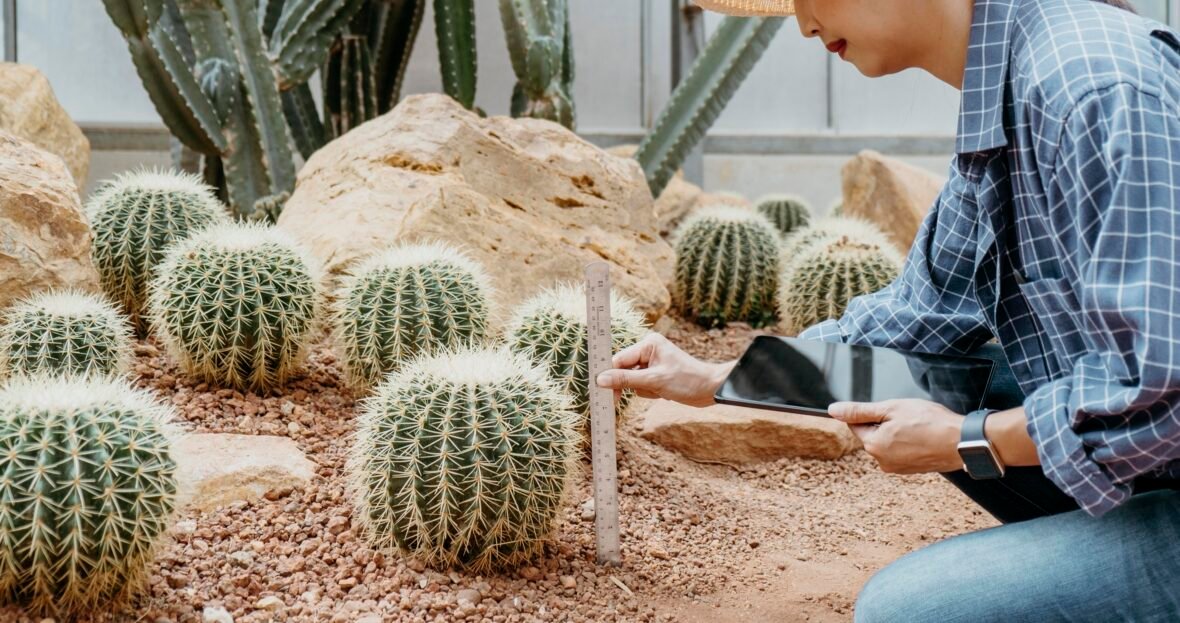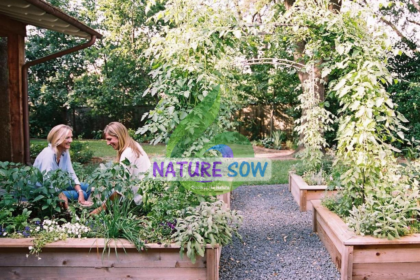Gardening in a desert environment provides distinct problems because to the severe heat, low rainfall, and sandy soils typical of these places. However, with the correct attitude and careful design, it’s possible to build a healthy garden that not only survives but also thrives in such difficult circumstances. Here are some vital strategies to help you create a lovely desert garden:
1. Choose Drought-Tolerant Plants
One of the secrets to successful gardening in a desert area is picking plants that are naturally designed to survive in dry circumstances. Fortunately, there is a broad array of drought-tolerant plant species that may add color, texture, and interest to your landscape while needing minimum water once established.
local Plants: Start by examining the local flora of your location. These plants have evolved to survive and grow in the local temperature and soil conditions, making them well-suited for arid settings. Examples of natural desert plants include cactus, succulents, agaves, yuccas, and desert shrubs like creosote bush and brittlebush.
Adapted Species: In addition to native plants, there are several non-native species that are well-suited to desert gardening. Look for plants branded as “drought-tolerant” or “xeric,” which are particularly developed or chosen for their capacity to resist low water circumstances. Some common selections are lavender, Russian sage, desert marigold, penstemon, and decorative grasses.
When picking plants for your desert garden, consider aspects such as sun exposure, soil type, and water needs. Group plants with comparable requirements together to make watering and upkeep more effective.
2. Use Mulch
Mulching is a simple but efficient practice for retaining soil moisture and controlling soil temperature, both of which are crucial in desert gardening. By coating the soil surface with a layer of organic or inorganic material, you may minimize evaporation, limit weed development, and enhance soil structure over time.
Organic Mulches: Materials such as wood chips, shredded bark, straw, or compost make ideal organic mulches for desert gardening. Apply a layer of mulch several inches deep around the base of plants, taking care to allow a small space between the mulch and the plant stems to avoid rot.
Inorganic Mulches: In locations where organic mulches may disintegrate fast or attract pests, you may use inorganic mulches like gravel, crushed stone, or volcanic rock. These materials give comparable advantages to organic mulches and also increase the visual appeal of your landscape.
Regardless of the sort of mulch you pick, make sure to replace it occasionally to preserve its efficacy. Mulching is especially crucial in desert regions, where soil moisture is sparse and temperatures may change considerably.
3. Water Efficiently
Water is a vital resource in arid regions, therefore it’s crucial to utilize it properly in your garden. To encourage healthy plant development while saving water, implement effective watering strategies that concentrate on providing moisture where it’s required most.
Deep Watering: Instead of regular shallow watering, attempt to water your plants deeply yet seldom. This fosters the growth of deep root systems, which are better able to reach moisture stored deep beneath the soil. Water gently and deeply to ensure that moisture reaches the root zone rather than running off the surface.
Drip Irrigation: Drip irrigation is a very effective form of watering that distributes water directly to the root zone of plants via a network of tubes and emitters. This saves water waste by lowering evaporation and runoff, and it helps you to focus water exactly where it’s required. Consider installing a drip irrigation system in your yard for best water economy.
Mulch and Soil Moisture Sensors: Mulching not only conserves moisture but also helps to manage soil moisture levels by minimizing fast evaporation. Additionally, you may use soil moisture sensors or meters to monitor soil moisture levels and decide when it’s time to water. These gadgets may assist avoid overwatering or underwatering, both of which can be damaging to plant health.
By implementing water-efficient strategies such as deep watering, drip irrigation, and mulching, you can guarantee that your garden gets the water it needs while reducing waste and supporting healthy plant development.
4. Provide Shade
In the high heat of a desert region, providing shade for your plants is crucial for protecting them from sunburn and heat stress. Shade not only helps to keep plants cool but also minimizes water loss via transpiration, helping them to preserve moisture more efficiently.
Natural shadow: Take use of existing structures such as buildings, trees, or huge boulders to produce natural shadow for your garden. Planting shade-providing trees or shrubs strategically may also assist to create microclimates inside your garden where plants can avoid the full force of the sun’s beams.
Artificial Shade: If natural shade is scarce, consider adding artificial shade structures such as shade cloth, pergolas, or arbors. These may be positioned over sensitive plants or whole garden beds to give respite from direct sunlight during the hottest portion of the day.
Temporary Shade: In severe heatwaves or during times of high sun exposure, you may offer temporary shade for your plants using umbrellas, shade sails, or cloth row covers. These portable shade solutions may be readily relocated as required to protect delicate plants from sun harm.
By adding shade into your garden design, you can create a more friendly habitat for your plants and help them survive despite the harsh circumstances of a desert climate.
5. Amended Soil
Desert soils are frequently sandy, rocky, or poor in organic matter, which may provide obstacles for plant development. To increase soil fertility, structure, and water retention, it’s vital to modify the soil with organic matter and other soil amendments.
Compost: Incorporating compost into the soil is one of the finest strategies to increase its fertility and structure. Compost offers important nutrients, improves soil texture, and boosts water retention, making it very valuable in desert gardening. Mix compost into the soil before planting, or use it as a top dressing around mature plants.
Aged Manure: Aged manure is another good source of organic matter for arid soils. It delivers nutrients, enhances soil structure, and fosters beneficial microbial activity. Be cautious to use well-aged manure that has been composted to reduce the danger of burning plant roots.
Mulch: As indicated previously, mulching the soil surface with organic materials like wood chips or straw may assist to store moisture, reduce weeds, and progressively improve soil structure over time. As the mulch breaks down, it provides organic matter to the soil, enriching it and boosting its potential to promote plant development.
By enriching your soil with compost, aged manure, and mulch, you may create a more friendly growth environment for your plants and help them survive despite the harsh circumstances of a desert climate.
6. Group Plants by Water Needs
In a desert garden, it’s necessary to put plants with comparable water needs together to ensure that they get the right quantity of moisture without wasting water on plants that don’t need it. By constructing “hydrozones” based on water demands, you may create an effective irrigation system that distributes water exactly where it’s required most.
High-Water Plants: Group plants that have high water needs together in one section of the garden. This can include thirsty annuals, veggies, or decorative plants that need frequent watering to flourish. By concentrating these plants in a single hydrozone, you can guarantee that they get appropriate moisture without overwatering other regions of the garden.
minimal-Water Plants: Similarly, arrange plants with minimal water needs together in another part of the garden. This could include drought-tolerant native plants, succulents, and cacti that are evolved to live with minimum watering. By combining these plants together, you may create a more water-efficient landscape that conserves resources while still encouraging healthy plant development.
Microclimates: Keep in mind that various regions of your garden may have distinct microclimates depending on characteristics such as sun exposure, wind exposure, and closeness to buildings or water features. Take use of these microclimates to establish specialized planting zones where plants with similar requirements may grow together.
By grouping plants by water demands and taking use of microclimates in your garden, you can build a more effective and sustainable irrigation system that encourages healthy plant development while saving water resources.
7. Harvest Rainwater
While rainfall may be infrequent in arid settings, when it does come, it gives a significant chance to gather and store water for later use in your garden. By gathering rainwater, you may augment your irrigation water supply, decrease dependency on municipal water sources, and cut water expenses.
Rain Barrels: Install rain barrels or cisterns to gather rainfall from your roof or other impermeable surfaces. These containers may be attached to downspouts or gutters to catch water runoff and store it for later use in your garden. Choose containers constructed from sturdy, food-grade materials and arrange them in a handy area near your plants.
Rain Gardens: Consider establishing a rain garden or bioswale to trap and absorb rainfall runoff from your land. These planted depressions are meant to catch and filter rainfall, enabling it to sink into the soil and replenish groundwater sources. Planting water-loving plants in and around rain gardens may assist to further minimize runoff and encourage water conservation.
Permeable Surfaces: Where practical, replace impermeable surfaces like concrete or asphalt with permeable alternatives such as gravel, pavers, or porous pavement. These materials let rainfall to soak into the soil instead of flowing off into storm drains, minimizing the danger of floods and erosion while recharging groundwater resources.
By collecting rainwater and utilizing it to irrigate your garden, you can take use of this precious resource and lessen your dependence on conventional water sources, making your garden more sustainable and resilient in the face of drought.
8. Provide Wind Protection
In addition to intense heat and little water, desert gardens must battle with powerful winds that may desiccate plants, erode soil, and inflict physical harm. Providing wind protection is vital for establishing a protected habitat where plants may grow despite these hard circumstances.
Windbreaks: Planting windbreaks around the perimeter of your garden may assist to lower wind velocity and provide a more protected microclimate inside the garden. Choose wind-resistant species such as evergreen trees, bushes, or grasses that can survive severe winds and create a barrier against gusts.
Fences and Walls: Installing sturdy fences or walls may also assist to limit wind exposure and protect fragile plants from harm. Position fences or barriers strategically to redirect prevailing winds away from sensitive portions of the garden, such as freshly planted beds or fragile plants.
Hedgerows: Dense hedges or hedgerows consisting of wind-resistant plants or grasses may offer efficient wind protection while also adding beauty and variety to your yard. Consider establishing a mixed hedge that comprises a range of species to produce a more durable and visually pleasing windbreak.
By providing proper wind protection for your garden, you may limit the negative impacts of wind exposure and provide a more hospitable habitat for your plants to grow in spite of the hard circumstances of a desert climate.
9. Choose the Right Time for Planting
Timing is key in desert gardening, particularly when it comes to planting. By picking the appropriate time to plant, you may offer your plants the greatest possible opportunity of establishing themselves before experiencing the full impact of summer heat and drought.
Cool Season Planting: In desert regions, the cool season (usually autumn through spring) is the optimum period for planting a broad variety of decorative and culinary plants. Cooler temperatures and increased humidity during this time of year decrease transplant shock and help plants to develop robust root systems before the start of summer heat.
Warm Season Planting: While planting during the hot summer months is typically not suggested owing to the stress it may put on plants, it is feasible to plant heat-tolerant species at this period provided you take additional steps to offer shade, water, and protection from high heat. Be cautious to water freshly planted seedlings and transplants often to help them grow roots in the hot, dry soil.
Monsoonal Planting: In certain arid places, summer monsoon rains give a small window of opportunity for planting and germination. Take advantage of these periodic rains by planting drought-tolerant seeds or seedlings immediately before or during the commencement of monsoon season, when soil moisture levels are maximum.
By timing your planting actions to coincide with the most ideal circumstances, you may give your plants a head start and boost their chances of thriving in the tough environment of a desert climate.
10. Monitor and Adjust
Finally, one of the most essential components of growing in a desert environment is to watch your garden regularly and be prepared to alter your gardening tactics as required in reaction to changing circumstances.
Observation: Take the time to monitor your garden often, paying attention to elements such as soil moisture levels, plant development, insect activity, and weather patterns. Look for symptoms of stress or dehydration in your plants, such as withering leaves, yellowing foliage, or slower growth, and take action swiftly to solve any concerns.
Flexibility: Be open to change your gardening tactics depending on your observations and the individual demands of your plants. This can require modifying your watering schedule, giving more shade or wind protection, enriching the soil with organic matter, or choosing more drought-tolerant plant species for future plantings.
Learning from Experience: Gardening in a desert environment is a constant learning process, and every season provides new problems and possibilities. Keep a gardening notebook to record your observations, achievements, and failures, and use this knowledge to develop your approach and enhance your gardening abilities over time.
By keeping watchful and receptive to the requirements of your garden, you may overcome the problems of growing in a desert environment and develop a beautiful and sustainable landscape that flourishes against the odds.
In conclusion, gardening in a desert climate demands careful planning, smart design, and a willingness to adapt to the specific difficulties of these harsh locations. By choosing drought-tolerant plants, using mulch to conserve moisture, watering efficiently, providing shade and wind protection, amending the soil, grouping plants by water needs, harvesting rainwater, timing your planting, and monitoring your garden closely, you can create a thriving oasis in the desert that brings beauty, biodiversity, and sustainability to your landscape. With patience, dedication, and a little of imagination, you may enjoy the advantages of gardening in even the most demanding of climates.





